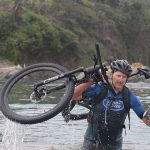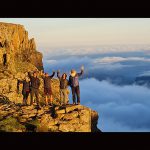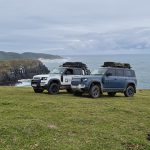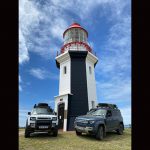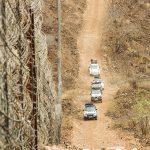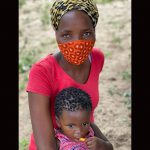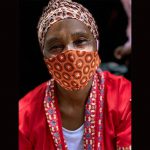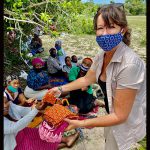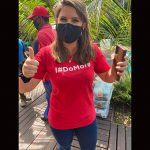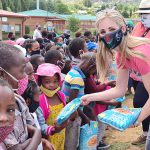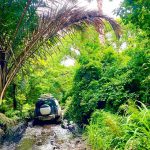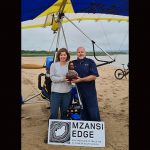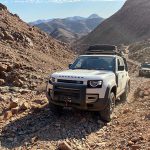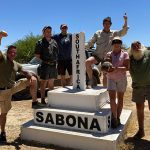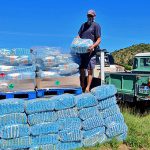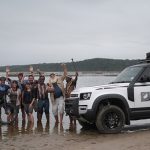What a fascinating adventure in our home country! With international borders still closed but with the easing of Covid-19 travel restrictions within South Africa, in September 2020 we set off on a fast-paced, 80-day, 16,000Km expedition to showcase the technical abilities of Land Rover’s recently launched New Defender 110 – all of us wildly excited to be back on the road again and doing what we do best.
Called the Mzansi Edge Expedition (‘Mzansi’ is a well-known colloquial term for South Africa, meaning ‘south’), it proved to be a challenging and inspirational journey over some of the roughest terrain on the continent in every type of extreme weather, and a marathon humanitarian aid effort.
Starting at Kosi Bay mouth in northern KwaZulu-Natal (South Africa’s most easterly geographic point) with the filling of our traditional Zulu calabash that travels on every humanitarian and geographic journey and armed with a new expedition Scroll of Peace and Goodwill, the expedition’s route closely tracked South Africa’s land borders with Mozambique, Eswatini, Zimbabwe, Botswana and Namibia, circumnavigated the land-locked Mountain Kingdom of Lesotho, and followed the entire length of the Atlantic and Indian Ocean coastlines.
Other geographic objectives of the expedition included reaching South Africa’s eastern, northern, western and southern geographic points and the erection of symbolic ‘isivivanes’ (stone cairns) at the six points where South Africa’s border meets two other countries. We also collected thimblefuls of water from 50 important rivers and water sources on Mzansi’s Edge in the Zulu calabash.
Staying true to the coastal section of the expedition’s route, we GPS-logged 50 lighthouses along South Africa’s Atlantic and Indian Ocean shorelines, often tackling convoluted deep sand tracks through dense forests and along the extreme edge of craggy cliffs to reach them.
Expedition veteran and Land Rover Cape Epic ambassador, ‘Shova Mike’ Nixon, one of only four people in the world to have completed every Absa Cape Epic mountain bike race, cycled over 4,500Km of the Mzansi Edge expedition route, including a gruelling 300Km solo journey along the beaches and cliffs of the Wild Coast.
Other well-known South African adventurers who participated in the expedition were good friends and acclaimed ‘7 Summits of the World’ mountaineers Andre BredenkampandSibusiso Vilane, the first African to successfully summit Mt Everest.
PUTTING THE NEW DEFENDER 110 THROUGH ITS PACES
The challenging Mzansi Edge route most definitely tested the two expedition-kitted New Defenders over some extreme terrain conditions, including:
- Following the entire length of the Mozambique and Eswatini borders along deep sand-forest tracks and boulder-strewn hill-paths, and the Kruger National Park’s 491Km fence line with Mozambique in lashing rain, wind and first-of-summer thunderstorms that turned sections of black-cotton soil into gluey skating rinks.
- Mud, mud and more mud: slip-sliding along almost non-existent dirt tracks to hug the Limpopo River boundary with Zimbabwe and Botswana.
- Tracking the 500Km straight-edge border with Namibia from the SABONA beacon at Union’s End in the north of the Kalagadi Transfrontier Park – a five-day, 4×4 adventure of rollercoaster-style dune-riding and catapulting the Defenders over countless high red Kalahari sand dunes.
- A week of extreme heat, dehydration, deep sand, slippery rocks, thick dust and kilometres of bone-shaking, teeth-rattling, suspension-busting corrugated roads through the Northern Cape deserts to track the Orange River border with Namibia.
- The first successful descent and ascent of the Northern Cape’s notorious ‘Road to Hell’ mountain pass (most dangerous in South Africa) for the New Defender, and through the ancient, haunting desert beauty of the Richtersveld mountains.
- Steep rocky ascents and descents along the top of the Lubombo and Makhonjwa mountain ranges, as well as the high-altitude Drakensberg escarpment to circumnavigate Lesotho in freezing rain, mist and mud.
- Tracking South Africa’s entire coastline from Alexander Bay (border with Namibia and SA’s most westerly point) on the Atlantic West Coast, through the restricted Diamond Coast to Cape Agulhas (Africa’s most southerly point), traversing the precipitous cliffs of the Wild Coast, and the full length of the Indian Ocean tropical forest coastline back to Kosi Bay on the Mozambique border.
HUMANITARIAN OBJECTIVES ACHIEVED
The Mzansi Edge Expedition helped thousands of needy families, early childhood development centres and orphanages all along South Africa’s ‘edge’, who were still suffering food shortages from the long months of the Covid-19 national lockdown, through the distribution of +270,000 nutritional DoMore meals, thousands of colourful ‘shweshwe’ cloth facemasks (made by Goodbye Malaria’s community-based sewing teams) and bars of sanitizing soap to needy families
And, for the first time since the start of Covid-19, we were able to provide Mashozi’s Rite to Sight eye tests and reading glasses to elderly, poor-sighted community residents – all with strict social distancing, mask-wearing and sanitizing of course.
A big thank you to Land Rover, the Do More Foundation, Goodbye Malaria and countless, big-hearted community volunteers who helped with the logistics of this mammoth goodwill effort.
Further thanks to all the extraordinary people we met on South Africa’s ‘edge’, who willingly hosted the expedition team and enthusiastically helped with the humanitarian work of this memorable, ‘home-grown’ expedition. South Africa truly is ‘a world in one country’.
 ,
, 

